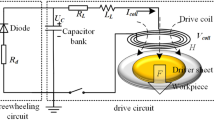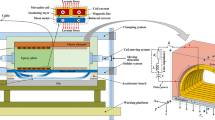Abstract
In order to improve energy efficiency, a driver plate made from high-conductivity material is normally used in the electromagnetic forming process of high-strength but low-conductivity sheet metal. The choice of driver plate significantly influences final deformation of the workpiece. In this paper, the electromagnetic free bulging process of Ti-6Al-4V titanium alloy sheet, widely used in aerospace, was studied by both experimental means and numerical simulation. The forming efficiency and quality of the workpiece under different types of driver plates were investigated in detail. The results show that by using high-conductivity and easily deformed materials such as aluminum alloy, with a skin depth in thickness, high efficiency and uniform deformation can be achieved. The results of this study can provide guidance on the choice of process parameters such as the material and thickness of a driver plate.
Similar content being viewed by others
References
Davies RW, Golovashchenko S, Carpenter JA (2005) Electromagnetic Forming of Aluminum Sheet. U.S. Department of Energy, Energy Efficiency and Renewable Energy, Washington, DC, 20585, USA,
Dariani BM, Liaghat GH, Gerdooei M (2009) Experimental investigation of sheet metal formability under various strain rates. Proceedings of the Institution of Mechanical Engineers, Part B: Journal of Engineering Manufacture 223(6):703–712. doi:10.1243/09544054jem1430
Daehn GS, Vohnout VJ, DuBois L (1999) Improved formability with electromagnetic forming: fundamentals and a practical example. Minerals, Metals and Materials Society/AIME, Sheet Metal Forming Technology (USA), pp 105–115, Mar 1999; 1999
Seth M, Vohnout VJ, Daehn GS (2005) Formability of steel sheet in high velocity impact. J Mater Process Tech 168(3):390–400. doi:10.1016/j.jmatprotec.2004.08.032
Takahashi M, Murakoshi Y, Terasaki M, Sano T, Matsuno KI (1988) Study on electromagnetic forming v. free bulging of high-strength-metal plates. II. J Mech Eng Lab (Jpn) 42(1):1–8
Tillmann W, Vogli E, Nebel J (2005) Thermally sprayed Cu layers. Electromagnetic forming of badly electrically conducting steel sheets. ZWF Z Wirtsch Fabrikbetr 100(7–8):451–454
Shin C, Jin HH, Lee JG, Lee D-J, Rhee C-K, Hong J-H (2008) Expansion of a low conductive metal tube by an electromagnetic forming process: finite element modeling. Met Mater-int 14(1):91–97
Sano T, Takahashi M, Murakoshi Y, Matsuno K (1986) Electromagnetic forming method by use of a driver. United States Patent
Bradley JR, Daehn GS (2011) Driver plate for electromagnetic forming of sheet metal. United States Patent
Li F, Mo J, Zhou H, Fang Y (2013) 3D Numerical simulation method of electromagnetic forming for low conductive metals with a driver. Int J Adv Manuf Tech 64(9–12):1575–1585. doi:10.1007/s00170-012-4124-1
Meyers MA (1994) Dynamic behavior of materials. Wiley, New York
Beley V, Ferrtik SM, Khimenko LT (1996) Electromagnetic metal forming handbook. English version of Russian book translated by Altynova MM, Ohio State University
Xu J, Yu H, Li C (2012) Effects of process parameters on electromagnetic forming of AZ31 magnesium alloy sheets at room temperature. Int J Adv Manuf Tech. doi:10.1007/s00170-012-4442-3
Kıranlı E (2009) Determination of material constitutive equation of a biomedical grade Ti6Al4V alloy for cross-wedge rolling. Izmir Institute of Technology, Izmir
Author information
Authors and Affiliations
Corresponding author
Rights and permissions
About this article
Cite this article
Li, F., Mo, J., Li, J. et al. Study on the driver plate for electromagnetic forming of titanium alloy Ti-6Al-4V. Int J Adv Manuf Technol 69, 127–137 (2013). https://doi.org/10.1007/s00170-013-5002-1
Received:
Accepted:
Published:
Issue Date:
DOI: https://doi.org/10.1007/s00170-013-5002-1




